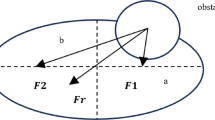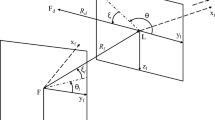Abstract
The purpose of this article is to control the formation of heterogeneous flying robots and to cross obstacles. The robots in question are a quadrotor and two unmanned helicopters. Independent attitude and position of robots and formation flight are controlled by the sliding mode method. Improved Artificial Potential Fields has been used to avoid collision with dynamic and static obstacles. The results of the design of the attitude and position controller showed that the attitude and position of the robots were well stabilized and converged in less than 3 s, which is a favorable time. The results of the formation flight simulation were presented in the form of 4 missions. In the first mission, the quadrotor is considered the leader, and the helicopters are the followers. The flight formation is triangular and the flight path is spiral. The results showed that the followers follow the leader. In the second mission, the robot crosses dynamic and static obstacles and the leader tracks the fixed target. In the third mission, the number of followers increases to 5 and the flight formation is hexagonal. The obstacles in this mission are dynamic and the target is moving. The results showed that in these two missions, the leader tracks the target well and the robots maintain triangular and hexagonal flight formations after crossing the obstacles. The results of simulations of group crossing of obstacles showed that the simulation error is less than 4% according to the expected position of the robots, and show the efficiency of the applied methods.





















Similar content being viewed by others
Abbreviations
- SMC:
-
Sliding Mode Control
- STSMC:
-
Super-Twisting Sliding Mode Control
- APF:
-
Artificial Potential Field
- UAV:
-
Unmanned Aerial Vehicles
- UA-GV:
-
Unmanned Air-Ground Vehicles
References
Nguyen, N.P., Park, D., Ngoc, D.N., Xuan-Mung, N., Huynh, T.T., Nguyen, T.N., Hong, S.K.: Quadrotor formation control via terminal sliding mode approach: theory and experiment results. Drones 6(7), 172 (2022). https://doi.org/10.3390/drones6070172
Mechali, O., Xu, L., Xie, X., Iqbal, J.: Theory and practice for autonomous formation flight of quadrotors via distributed robust sliding mode control protocol with fixed-time stability guarantee. Control Eng. Pract. 123, 105150 (2022). https://doi.org/10.1016/j.conengprac.2022.105150
Mechali, O., Xu, L., Xie, X.: Nonlinear homogeneous sliding mode approach for fixed-time robust formation tracking control of networked quadrotors. Aerosp. Sci. Technol. 126, 107639 (2022). https://doi.org/10.1016/j.ast.2022.107639
González-Sierra, J., Dzul, A., Martínez, E.: Formation control of distance and orientation based-model of an omnidirectional robot and a quadrotor UAV. Robot. Auton. Syst. 147, 103921 (2022). https://doi.org/10.1016/j.robot.2021.103921
Cheng, W., Zhang, K., Jiang, B., Ding, S.X.: Fixed-time fault-tolerant formation control for heterogeneous multi-agent systems with parameter uncertainties and disturbances. IEEE Trans. Circuits Syst. I Regul. Pap. 68(5), 2121–2133 (2021). https://doi.org/10.1109/TCSI.2021.3061386
ong, G., Ma, J., Jiang, Y., Mao, Z.: Distributed adaptive fault-tolerant formation control for heterogeneous multiagent systems under switching directed topologies. J. Franklin Inst. 359(8), 3366–3388 (2022). https://doi.org/10.1016/j.jfranklin.2022.03.048
Zhao, W., Liu, H., Wan, Y., Lin, Z.: Data-driven formation control for multiple heterogeneous vehicles in air–ground coordination. IEEE Trans. Control Netw. Syst. 9(4), 1851–1862 (2022). https://doi.org/10.1109/TCNS.2022.3181254
Yu, D., Zhou, P., Jing, Y.: Optimal obstacle avoidance consensus formation control method for fixed-wing UAV with variable topology. Aerosp. Syst. 5(1), 75–84 (2022). https://doi.org/10.1007/s42401-021-00119-5
Cong, Y., Du, H., Jin, Q., Zhu, W., Lin, X.: Formation control for multiquadrotor aircraft: connectivity preserving and collision avoidance. Int. J. Robust Nonlinear Control 30(6), 2352–2366 (2020). https://doi.org/10.1002/rnc.4886
Vargas, S., Becerra, H.M., Hayet, J.B.: MPC-based distributed formation control of multiple quadcopters with obstacle avoidance and connectivity maintenance. Control. Eng. Pract. 121, 105054 (2022). https://doi.org/10.1016/j.conengprac.2021.105054
Yan, S., Pan, F.: Research on route planning of auv based on genetic algorithms. In: 2019 IEEE International Conference on Unmanned Systems and Artificial Intelligence (ICUSAI), pp. 184–187, IEEE, (2019). https://doi.org/10.1109/ICUSAI47366.2019.9124785
MahmoudZadeh, S., Powers, D.M., Yazdani, A.M., Sammut, K., Atyabi, A.: Efficient AUV path planning in time-variant underwater environment using differential evolution algorithm. J. Mar. Sci. Appl. 17, 585–591 (2018). https://doi.org/10.1007/s11804-018-0034-4
Che, G., Liu, L., Yu, Z.: An improved ant colony optimization algorithm based on particle swarm optimization algorithm for path planning of autonomous underwater vehicle. J. Ambient Intell. Humaniz Comput. 11, 3349–3354 (2020). https://doi.org/10.1007/s12652-019-01531-8
Lim, H.S., Fan, S., Chin, C.K., Chai, S., Bose, N.: Particle swarm optimization algorithms with selective differential evolution for AUV path planning. Int. J. Robot. Autom. 9(2), 94–112 (2020). https://doi.org/10.11591/ijra.v9i2
Li, X., Wang, W., Song, J., Liu, D.: Path planning for autonomous underwater vehicle in presence of moving obstacle based on three inputs fuzzy logic. In: 2019 4th Asia-Pacific Conference on Intelligent Robot Systems (ACIRS), pp. 265–268, IEEE, (2019). https://doi.org/10.1109/ACIRS.2019.8936029
Sun, B., Zhu, D., Tian, C., Luo, C.: Complete coverage autonomous underwater vehicles path planning based on glasius bio-inspired neural network algorithm for discrete and centralized programming. IEEE Trans. Cogn. Dev. Syst. 11(1), 73–84 (2018). https://doi.org/10.1109/TCDS.2018.2810235
Taheri, E., Ferdowsi, M.H., Danesh, M.: Closed-loop randomized kinodynamic path planning for an autonomous underwater vehicle. Appl. Ocean Res. 83, 48–64 (2019). https://doi.org/10.1016/j.apor.2018.12.008
Zhao, Y., Hao, L.Y., Wu, Z.J.: Obstacle avoidance control of unmanned aerial vehicle with motor loss-of-effectiveness fault based on improved artificial potential field. Sustainability 15(3), 2368 (2023). https://doi.org/10.3390/su15032368
Havenstrøm, S.T., Rasheed, A., San, O.: Deep reinforcement learning controller for 3D path following and collision avoidance by autonomous underwater vehicles. Front. Rob. AI. 211 (2021). https://doi.org/10.3389/frobt.2020.566037
Pan, Z., Zhang, C., Xia, Y., Xiong, H., Shao, X.: An improved artificial potential field method for path planning and formation control of the multi-UAV systems. IEEE Trans. Circuits Syst. II Express Briefs 69(3), 1129–1133 (2021). https://doi.org/10.1109/TCSII.2021.3112787
Huang, Y., Tang, J., Lao, S.: UAV group formation collision avoidance method based on second-order consensus algorithm and improved artificial potential field. Symmetry 11(9), 1162 (2019). https://doi.org/10.3390/sym11091162
Chang, K., Ma, D., Han, X., Liu, N., Zhao, P.: Lyapunov vector-based formation tracking control for unmanned aerial vehicles with obstacle/collision avoidance. Trans. Inst. Meas. Control. 42(5), 942–950 (2020). https://doi.org/10.1177/0142331219879338
Zhao, T., Zhang, J., Rong, K., Zhang, W.: Collision Avoidance Algorithm for UAV Formation Reconfiguration Under UV Non-uniform Virtual Potential Field. 电子与信息学报, 44, 1–9, (2022). https://doi.org/10.11999/JEIT220442
Ning, W., Jiyang, D., Jin, Y.: UAV formation recovery and consistency Simulation based on improved potential field. J. Syst. Simulation, 34(5), 978, (2022). https://doi.org/10.16182/j.issn1004731x.joss.20-0980
Prouty, R.: Helicopter performance, stability, and control, pp. 143– 146, 476–477. Krieger Publishing Company, Malabar (1990)
Pounds, P., Mahony, R., Corke, P.: Modelling and control of a quad-rotor robot. In: Proceedings of the 2006 Australasian Conference on Robotics and Automation, Australian Robotics and Automation Association (ARAA), pp. 1–10, (2006)
Newman, S.: The foundations of helicopter flight, pp. 107–116. Halsted Press, New York, NY (1994)
Hoffmann, G., Waslander, S.L., Huang, H., Tomlin, C.J.: Autonomous Quadrotor helicopter testbed design, control, and experiments. AIAA Journal of Guidance, Control, and Dynamics. (2007)
Joelianto, E., Maryami Sumarjono, E., Budiyono, A., Retnaning Penggalih, D.: Model predictive control for autonomous unmanned helicopters. Aircr. Eng. Aerosp. Technol. 83(6), 375–387 (2011). https://doi.org/10.1108/00022661111173252
Bangura, M., Mahony, R.: Nonlinear dynamic modeling for high performance control of a quadrotor. (2012). https://doi.org/10.1109/ICInfA.2015.7279823
Mechali, O., Iqbal, J., Mechali, A., Xie, X., Xu, L.: Finite-time attitude control of uncertain quadrotor aircraft via continuous terminal sliding-mode-based active anti-disturbance approach. In: 2021 IEEE International Conference on Mechatronics and Automation (ICMA), pp. 1170–1175, IEEE, (2021). https://doi.org/10.1109/ICMA52036.2021.9512751
Ghadiri, H., Emami, M., Khodadadi, H.: Adaptive super-twisting non-singular terminal sliding mode control for tracking of quadrotor with bounded disturbances. Aerosp. Sci. Technol. 112, 106616 (2021). https://doi.org/10.1016/j.ast.2021.106616
Kotov, K.Y., Mal’tsev, A.S., Nesterov, A.A., Sobolev, M.A., Yan, A.P.: Decentralized control of quadrotors in a leader–follower formation. Optoelectron. Instrum. Data Process. 53, 21–25 (2017). https://doi.org/10.3103/S8756699017010046
Khatib, O.: Real-time obstacle avoidance for manipulators and mobile robots. Int. J. Robot. Res. 5(1), 90–98 (1986). https://doi.org/10.1177/027836498600500106
Zhou, P., Lai, S., Cui, J., Chen, B.M.: Formation control of unmanned rotorcraft systems with state constraints and inter-agent collision avoidance. Auton. Intell. Syst. 3(1), 4 (2023). https://doi.org/10.1007/s43684-023-00049-3
Liu, H., Tu, H., Huang, S., Zheng, X.: Adaptive predefined-time sliding mode control for QUADROTOR formation with obstacle and inter-quadrotor avoidance. Sensors 23(5), 2392 (2023). https://doi.org/10.3390/s23052392
Li, B., Gong, W., Yang, Y., Xiao, B.: Distributed fixed-time leader-following formation control for multi-quadrotors with prescribed performance and collision avoidance. IEEE Trans. Aerosp. Electron. Syst. (2023). https://doi.org/10.1109/TAES.2023.3289480
Ma, Z., Wang, Q., Chen, H.: A joint guidance and control framework for autonomous obstacle avoidance in quadrotor formations under model uncertainty. Aerosp. Sci. Technol. 138, 108335 (2023). https://doi.org/10.1016/j.ast.2023.108335
Author information
Authors and Affiliations
Corresponding author
Ethics declarations
Conflict of interest
The authors (Fatemeh Ghaderi, Alireza Toloei, Reza Ghasemi) declare that they have no conflict of interest.
Additional information
Publisher’s Note
Springer Nature remains neutral with regard to jurisdictional claims in published maps and institutional affiliations.
Rights and permissions
Springer Nature or its licensor (e.g. a society or other partner) holds exclusive rights to this article under a publishing agreement with the author(s) or other rightsholder(s); author self-archiving of the accepted manuscript version of this article is solely governed by the terms of such publishing agreement and applicable law.
About this article
Cite this article
Ghaderi, F., Toloei, A. & Ghasemi, R. Heterogeneous Formation Sliding Mode Control of the Flying Robot and Obstacles Avoidance. Int. J. ITS Res. (2024). https://doi.org/10.1007/s13177-024-00396-2
Received:
Revised:
Accepted:
Published:
DOI: https://doi.org/10.1007/s13177-024-00396-2




